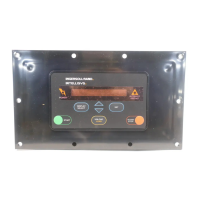43
4.0 External Electrical Disturbances:
Background
These are defined as sources of interference that can adversely affect signal
integrity of control systems and wiring interfaces. These types of problems can
be caused by Radio Frequency Interference (RFI), Electro-Magnetic Interference
(EMI), Electro-Static Discharge (ESD), lightning disturbances, and power line
transients and surges. Control circuits that are the most susceptible to these
disturbances include power supplies, sensors (pressure and temperature), and
external interface wiring such as remote starter interface and communications
port interfaces.
Note: The effects of external electrical disturbances are
magnified if the equipment is not properly grounded (see Grounding Problems).
Intellisys based control systems have been designed and tested for immunity
against external electrical disturbances. The test standard is derived from the
EC Directive (European Community Directive) for heavy industrial applications
and is known as EN50082-2. These test standards are specified to simulate
severe electrical disturbances that can occur in heavy industrial applications.
Intellisys control systems have passed at the levels specified.
The test parameters and compliance criteria are listed below:
EN 61000-4-2 Electrostatic Discharge Immunity
+/-4 KV contact discharge, +/- 8 KV air discharge
ENV50140 Radiated Electromagnetic Field Immunity
10 V/m, 80 to 1000 MHz (80% AM w/1kHz sinewave)
900 +/- MHz, 10 V/m pulse modulated at 200 Hz to 50 % duty
cycle per ENV50204
ENV50141 Conducted RF Disturbance Immunity
10 V rms (80% AM w/ 1 kHz sinewave) on all power and signal
lines
EN 610004-4 Electrical Fast Transient/Burst Immunity
+/- 2 kV on all power signals lines
EN 61000-4-8 Power Frequency Magnetic Field Immunity
30 A rms/m continuous at 50 Hz
RFI and EMI disturbances can be airborne as well as conducted into the
equipment. The source of this type of disturbance includes radio transmitters,
variable speed motor drives (VFD), switching power supplies, arc welding

